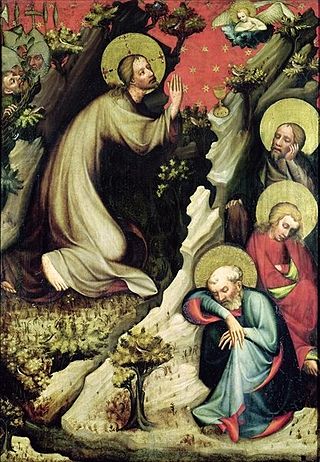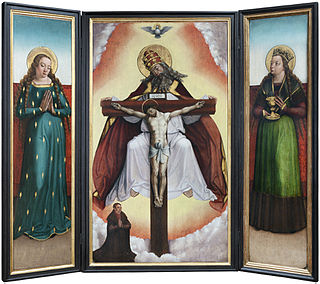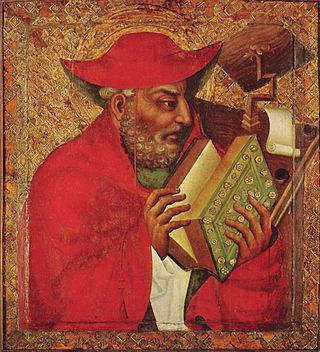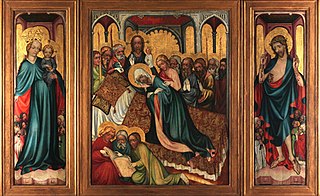
Master Theodoric, in Latin Magister Theodoricus was a Czech painter. He is the best documented Gothic painter in Bohemia. He was the favourite court painter of Charles IV, Holy Roman Emperor. and the first Bohemian painter whose name can be linked to a body of work. Theodoric is considered the chief representative of the phase of International Gothic known as "the Soft style". His masterpiece is the Chapel of the Holy Cross at Charles' newly completed Karlštejn Castle, near Prague, containing a large series of slightly over-lifesize half-length panel portraits of saints and other notable figures on a gold ground. The whole decoration of the chapel was commissioned in 1359 and completed over a number of years. The decoration of the Chapel of the Holy Cross was unique and unprecedented at the north of the Alps. Theodoric's oeuvre is not comparable to anything in European art after the mid-14th century (1360th).

The Třeboň Altarpiece, also known as Wittingau altarpiece, is one of the most important works of European Gothic panel painting. Of the original large altarpiece retable created in about 1380 by an anonymous Gothic painter called the Master of the Třeboň Altarpiece, three wings, painted on both sides, have survived. The altarpiece is one of the works that helped towards the emergence of the International Gothic style and which influenced the development of art in a broad European context.

The St. Vitus Madonna comes from the treasure of St. Vitus Cathedral in Prague and is exhibited in its original frame in the permanent collection of the National Gallery in Prague.

The Roudnice Madonna is a work by the Bohemian Master of the Třeboň Altarpiece from the period between 1385 and 1390. It came from the monastery of the Augustinian Canons in Roudnice nad Labem or from the Roudnice summer residence of Archbishop Jan of Jenštejn. The painting has been exhibited since 1946 in the permanent collection of medieval art at the National Gallery in Prague.

St Jude Thaddaeus is an oil on tempera painting by Bohemian master Master Theodoric, created around 1360-1364.

The Vyšší Brod (Hohenfurth) cycle, ranks among the most important monuments of European Gothic painting. It is made up of nine panel paintings depicting scenes from the Life of Christ, covering his childhood, Passion and resurrection. These paintings were made between 1345 and 1350 in the workshop of the Master of Vyšší Brod that was most probably based in Prague. The pictures were either meant for a square altar retable or else they decorated the choir partition of the church of the Cistercian Abbey in Vyšší Brod.

The Altarpiece of the Holy Trinity is a work by the Master of the Litoměřice Altarpiece dating from c. 1520. It is on display in the permanent collection of the National Gallery in Prague.

Madonna of Žebrák is a fully sculpted Gothic wooden statue, the work of an anonymous carver known as the Master of the Madonna of Žebrák, who worked at the same time as the Master of the Třeboň Altarpiece and was close to him in his artistic style. The sculpture occupies an exceptionally important place in the development of Czech sculpture of the late 14th century and forms a wooden counterpart to the beautiful Madonnas carved in marlstone. As a loan from the parish church of St. Lawrence in Žebrák, it is on display in the exposition of medieval art of the National Gallery in Prague.

Saint Luke the Evangelist is one of the most impressive panel paintings by Master Theodoric, intended for the decoration of the Chapel of the Holy Cross in Karlštejn. It may be a self-portrait of Theodoric himself. It is exhibited in the collection of medieval art of the National Gallery in Prague.

Saint Jerome is one of the finest paintings by Master Theodoric in the Chapel of the Holy Cross at Karlštejn. He has an honourable place in the hierarchy of the Holy Fathers and his portrait is placed in the south window niche of the chapel together with St. Augustine, St. Ambrose and St. Gregory. It is one of the oldest and most frequently reproduced depictions of St. Jerome. The painting is exhibited in the collection of medieval art of the National Gallery in Prague.

Saint Maurice is an oil tempera on beech board painting by Bohemian painter Master Theodoric, created around 1360-1365. It is probably the first depiction of a black man in Czech painting. The extraordinary importance of this knight in the conception of the Chapel of the Holy Cross is evidenced by the portrait's placement in the main space of the presbytery adjacent to the painting of St. George and the Bohemian patron saint St. Vitus.

Saint Catherine of Alexandria is an oil tempera on beech board painting by Bohemian Gothic painter Master Theodoric. It stands out among Theodoric's paintings in the Chapel of the Holy Cross, especially for her richly decorated clothing. The painting is exhibited in the collection of medieval art of the National Gallery in Prague.

Saint Simon is an oil tempera on beech board painting attributed to Master Theodoric, created around 1360-1365. In the Chapel of the Holy Cross at Karlštejn, his image is placed on the eastern (epistle) wall of the presbytery behind a dividing metal grille.

Saint Charlemagne is an oil tempera on beech board painjting by Czech painter Master Theodoric. It is included in the set made for the Chapel of the Holy Cross at Karlštejn by the artist himself. The portrait was placed in a prominent position in the middle of the row of rulers on the west wall of the nave. The quality of the artwork ranks it among the finest works of 14th century European painting. The painting is on display in the collection of medieval art of the National Gallery in Prague.

The Roudnice Altarpiece is a three-part winged altar from the provost's church in Roudnice nad Labem, one of the oldest completely preserved Gothic retables from the period around 1410-1420. It is on display in the permanent exhibition of the National Gallery in Prague.

St George's Altar is a large Gothic altarpiece from the 1460s-70s, originally placed in the St George's Convent at Prague Castle. It belongs to the property of the Metropolitan Chapter of St. Vitus and is on loan to the exhibition of medieval art of the National Gallery in Prague.

Crucifixion from Nové Sady, is part of a larger altar polyptych called the Rajhrad Altarpiece. Its author is the last important personality of Czech panel painting of the pre-Hussite period, known as the Master of the Rajhrad Altarpiece. The painting is on display in the permanent exhibition of the National Gallery in Prague.

The Ark of Doudleby (1494) is a set of three double-sided painted panels that were part of a winged altar, the centre of which was probably a cabinet with a statue of Pieta. This incompletely preserved altar is the finest set of late Gothic paintings in the collection of the Aleš South Bohemian Gallery in Hluboká nad Vltavou.

Puchner's Ark is a Gothic retable commissioned in 1482 by Nikolaus Puchner, Grand Master of the Knights of the Cross with the Red Star, for the church of St. Francis of Assisi in Prague's Old Town. The anonymous author of the panel paintings is referred to as the Master of the Puchner Altar. Part of the altar is on display in the National Gallery in Prague.
Master of the Luxembourg Genealogy was the court painter of the Holy Roman Emperor Charles IV. He is referred to by his most important work, the murals with figures of the monarchs in the imperial palace at Karlštejn Castle.
























